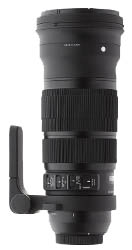Sigma 120-300mm f/2.8 review: Sigma’s big tele-zoom lens gets a makeover with improved optics and build, but one strange quirk
posted Monday, August 5, 2013 at 10:59 AM EDT

We've just posted our Sigma 120-300mm f/2.8 DG OS HSM "S" lens review, which is Sigma's first Global Vision lens in their "Sport" category of high-performance, fast-aperture lenses. Available since May 2013, the 120-300mm f/2.8 DG OS HSM "S" is functionally the same as its predecessor, the 120-300mm f/2.8 EX DG OS HSM APO, but has undergone Sigma's "Global Vision" redesign. It features a whole new barrel construction, updated mechanics and a new autofocus algorithm. Like the older model, it's designed for full-frame DSLRs, but also works just fine on APS-C cameras. It is currently available in Canon, Nikon and Sigma mounts.
The Sigma 120-300mm f/2.8 covers an impressive zoom range with a constant f/2.8 aperture. And it's a lens that doesn't have a direct competitor from other lens makers. Be warned: A substantial zoom combined with that aperture make this lens quite a heavy beast, tipping the scales at around 8 pounds with lens hood and tripod foot attached. If you think you can manage without a tripod, Sigma has thankfully included its Optical Stabilization system in the lens, offering up to 4 stops of shutter correction. We had some unexpected results with the 120-300mm's image stabilization, specifically at the wide end, but we don't think it's necessarily a deal breaker.
Optically, the new Sigma telephoto zoom lens produces great images on both full-frame and APS-C cameras, even when set to its widest aperture. Other factors like chromatic aberration and vignetting are very well-controlled, as is distortion.
Click on over to SLRgear and go in-depth with our Sigma 120-300mm f/2.8 DG OS HSM "S" lens review for more details on the optical performance and handling -- as well as a further explanation of the quirks with the Optical Stabilizer system -- of Sigma's latest pro-grade telephoto zoom lens.
Meanwhile, check out a few sample images below that we captured with the lens during some real-world testing.



